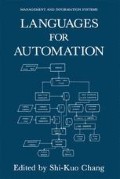Abstract
Controllers of industrial robot arms basically use positional information, generally programmed in a language which has no concept of an object other than as occupying a fixed position. They require a well-structured work environment before they can operate effectively. Three features characterize these robots: few degrees of freedom (DOF), little use of dynamic sensory information, and limited control architectures. Sensors to measure other physical features, and world-modeling robot systems, which present the user with a looser tie between object and position, are under active development.(1,5,17,23) However, we maintain that lack of sufficient sensory information is not the only problem, there is also the interfacing of sensory information to motor behavior.
Access this chapter
Tax calculation will be finalised at checkout
Purchases are for personal use only
Preview
Unable to display preview. Download preview PDF.
References
A. P. Ambler, I. M. Bellos, and R. J. Popplestone, An interpreter for a language for describing assemblies, Artif. Intell 14, 79–107 (1980).
M. A. Arbib, Perceptual structures and distributed motor control, in Handbook of Physiology—The Nervous System, II. Motor Control, ( V. B. Books, ed.) American Physiological Society, Bethesda, Maryland, 1981, pp. 1449–1480.
M. A. Arbib, T. Ibe.Rall, and D. Lyons, Coordinated control programs for movements of the hand, in Hand Function and the Neocortex,(A. W. Goodwin and I. Darin-Smith, eds.), Springer Verlag, 1985, pp. 111–129. Coins Technical Report 83–25,Department of Computer and Information Sciences, University of Massachusetts, Amherst, Massachusetts, (1983).
M. A. Arbib, K. J. Overton, and D. T. Lawton, Perceptual systems for robots, Interdiscip. Sci. Rev 9 (1), 31–46 (1984).
S. Bege,I, An optical tactile array sensor, Coins Technical Report 84–26, Department of Computer and Information Sciences, University of Massachusetts, Amherst, Massachusetts (1984). Proceedings of the Spie Conference on Intelligent Robots and Computer Vision, Cambridge, Massachusetts, November, 1984.
R. S. Fearing, Exploration of the dextrous hand control problem, General Electric Technical Report 82Crd337, December, 1982.
J. J. Gibson, The Senses Considered as Perceptual Systems, Houghton-Mifflin, Boston, 1966.
A. R. Hanson and E. M. RtsE:Man, Visions: A computer system for interpreting scenes, in Compter Vision Systems, ( A. R. Hanson and E. M. Riseman, eds.), Academic, New York, 1978, pp. 303–333.
J. M. Holle.Rbach, An oscillation theory of handwriting, Biol. Cybern 39, 139–156 (1981).
D. H. Hubel and T. N. Wiesel, Sequence regularity and geometry of orientation columns in the monkey striate cortex,/ Comp. Neurol. 158, 267–294 (1974).
M. Jeannerod, The timing of natural prehension movements,/ Motor Behay 16(3), 235254 (1984).
M. Jeannerod and B. Biguer, Visuomotor mechanisms in reaching within extrapersonal space, in Advances in the Analysis of Visual Behavior, ( D.J. Ingle, M.A. Goodale, and R.J.W. Mansfield, eds.), Mit Press, Cambridge, Massachusetts, 1982, pp. 387–409.
M. JE:Annerod, F. Michel, and C. Prabi.Anc, The control of hand movements in a case of hemianaesthesia following a parietal lesion, Brain, 107, 899–920 (1984).
E. R. Kandei., Central representation of touch, in Principles of Neural Science, ( E.R. Kan-del and J.H. Schwartz, eds.), Elsevier/North-Holland, New York, 1981, pp. 184–198.
I. A. Kapandii, The Physiology of the Joints. Vol 1, Upper Limb, 5th Edition, Churchill Liningstone, Edinburgh, 1982.
D. Lee:, Visuo-motor coordination in space-time, in Tutorials in Motor Behavior, ( G. Stelmach and J. Requin, eds.), North-Holland, Amsterdam, 1980.
L. I. Liebermann and M. A. Wesley, Autopass: An automatic programming system for computer controlled mechanical assembly, Ibmj. Res. Dev 21(4) (1977).
D. Lyons and M. A. Arbib, A schema-based system for hand movement, Coins Technical Report,Department of Computer and Information Science, University of Massachusetts, Amherst, Massachusetts, (in preparation).
D. I. Mccloskey and S. C. Gandevia, Role of inputs from skin, joints and muscles and of corollary discharges, in human discriminatory tasks, in Active Touch, ( G. Gordon, ed.), Pergamon, Oxford, 1978, pp. 177–187.
J. Napier, The prehensile movements of the human hand, J. Bone and Joint Surgery, 38B(4), 902–913 (1956).
U. NE:Isse.R, Cognition and Reality: Principles and Implications of Cognitive Psychology, Freeman, San Francisco, 1976.
T. A. Noyes, G. Pocock, and J. Franklin, Design of a Forth-based robot control language, Proceedings of 1983 Rochester Forth Applications Conference,June 1983, pp. 133140.
K. Overton, The acquisition, processing, and use of tactile sensor data in robot control, Ph.D. dissertation, Department of Computer and Information Science, University of Massachusetts, Amherst, Massachusetts (1984).
J. K. Salisbury, Kinematic and force analysis of articulated hands, Ph.D. dissertation, Department of Computer Science, Stanford University, Stanford, California 1982.
G. M. Shepherd, Neurobiology, Oxford, New York, 1983.
R. Tubiana, Architecture and functions of the hand, in The Hand, (R. Tubiana, ed.), Vol. 1, W.B. Saunders, Philadelphia, 1981, pp. 19–93.
Author information
Authors and Affiliations
Editor information
Editors and Affiliations
Rights and permissions
Copyright information
© 1985 Springer Science+Business Media New York
About this chapter
Cite this chapter
Iberall, T., Lyons, D. (1985). Perceptual Robotics: Toward a Language for the Integration of Sensation and Perception in a Dextrous Robot Hand. In: Chang, SK. (eds) Languages for Automation. Management and Information Systems. Springer, Boston, MA. https://doi.org/10.1007/978-1-4757-1388-6_20
Download citation
DOI: https://doi.org/10.1007/978-1-4757-1388-6_20
Publisher Name: Springer, Boston, MA
Print ISBN: 978-1-4757-1390-9
Online ISBN: 978-1-4757-1388-6
eBook Packages: Springer Book Archive

